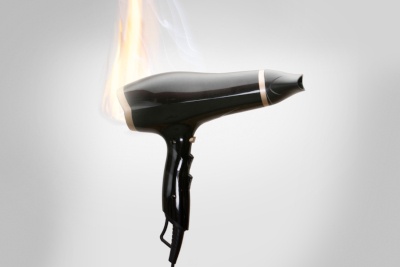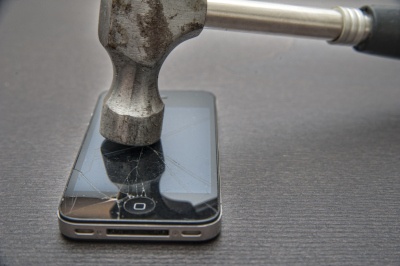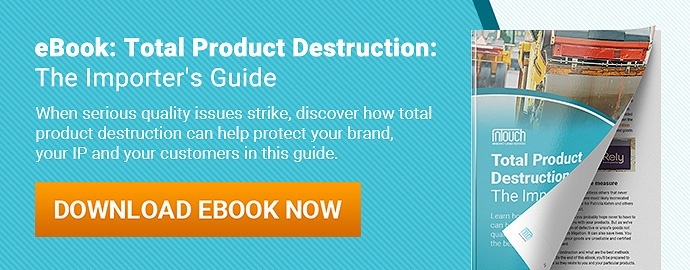Y ou’ll probably have to deal with defective products at one time or another as an importer. Despite your best efforts, perfection in manufacturing is rarely achievable and almost always expensive.
ou’ll probably have to deal with defective products at one time or another as an importer. Despite your best efforts, perfection in manufacturing is rarely achievable and almost always expensive.
Many experienced importers rely on pre-shipment product inspection to identify defective products and prevent them from reaching their customers. But what should you do with defective products after you find them?
Should you ask your supplier to rework the substandard goods? Should you rework the products in your home country instead? Or maybe destroy the affected goods completely to keep them from being sold in unauthorized channels (related: Total Product Destruction: The Importer’s Guide [eBook])?
An importer’s job in handling defective products doesn’t stop at conducting an inspection. You still need to take steps after inspection to ensure substandard goods don’t end up in the wrong hands. Failure to choose the right option for your substandard goods can lead to financial losses, liability issues and even more quality issues for your business.
No importer wants to have to face defective products. But that’s no excuse for mishandling substandard goods at the expense of your brand’s reputation. So let’s take a look at the top five mistakes importers make when handling defective products to help you avoid them.
1. Conducting rework that introduces new product defects
Imagine you’re an importer of polished kitchen knives. What’s more important to you, scratch-free knives or sharp knives?
Sometimes the process of reworking defective products to remove or fix a defect can cause new defects to appear. If a knife has a deep and long scratch, the factory may need to re-polish the casing to remove the defect. Though this may reduce the visibility of the scratch, over-polishing may cause the knives to become blunt.
In situations like these, you need to decide what’s worse—the initial defect or the risk of introducing a more serious defect into the product during rework. It’s often better to accept a minor defect affecting a product’s appearance than to risk creating a more serious defect that will impact function or safety. In this case, your customers would probably rather receive a scratched knife than a blunt knife.
Product rework is one of the most common defect management strategies importers employ. But that doesn’t mean it’s always the right solution. Factory staff might also introduce new defects during rework when:
- Unpacking and repacking defective products
- Moving defective products from the inspection site to their production/rework area
- Disassembling and reassembling the product, if necessary
Factory staff might also use incorrect parts or materials or follow the wrong instructions when reworking goods. Make sure you understand exactly what the quality issue is with the defective product and how factory workers will attempt to remedy it before considering rework as an option.
How to decide if rework is right for your defective products
Importers should typically assess whether to conduct product rework based on a few key considerations:
- Severity of the defect and the rework processes involved: Major and critical defects might be more difficult to rework than minor defects and might introduce new issues into the product.
- Cost of rework: What is the cost of rework in comparison to the cost of the product? Even if your supplier will be conducting the rework, they’re going to pass any related costs onto you one way or another. For low-cost consumer products, the cost of rework might not be worthwhile.
- Time required for rework: Will rework delay your shipment? Do you need to keep to a strict deadline? Will you incur fees from your retailer for a late shipment?
If you do proceed with product rework, be sure to conduct a re-inspection once rework is completed. A re-inspection helps you confirm that the factory actually resolved the issue and that no new defects were introduced into the products during rework.
2. Shipping defective products with plans to rework them after receiving them
If you’re eager to receive your order, you may agree to ship substandard goods in their current state with the intention of reworking them in your home country.
But depending on the size of your shipment and the severity of defects, reworking goods yourself can be a time-consuming and costly process. To rework defective products, you might need to:
- Hire additional labor, perhaps even skilled technicians, at local, often higher, rates
- Source raw materials and replacement components, perhaps from overseas, as some materials might be unavailable locally
- Acquire new equipment for rework processes
- Rent a warehouse to store the substandard goods and conduct rework, if existing facilities are insufficient
 Some companies exist in the U.S. or other Western countries that specialize in product rework. But these services can be expensive and often require a minimum order quantity or price. They may also require a long lead time or several weeks to complete the project, depending on availability.
Some companies exist in the U.S. or other Western countries that specialize in product rework. But these services can be expensive and often require a minimum order quantity or price. They may also require a long lead time or several weeks to complete the project, depending on availability.
Save yourself the money and headache of finding a reworking company by simply ensuring the original manufacturer has performed any rework before shipping.
Take a tip from the factory compliance industry—“trust, then verify”. As long as you consider the risk factors for rework and conduct a re-inspection to verify, it’s safe to entrust the job to your supplier. They will already have the equipment and personnel on-site to complete the job efficiently and adequately.
Depending on the product and quality issues found, factories can often complete rework in just a few days, or even hours, after inspection. Some importers require their suppliers to rework goods concurrently with inspection, having them ready the next day for re-inspection.
Consider conducting a during production inspection to reduce shipment delays
If you’re concerned about rework delaying shipments after pre-shipment inspection, consider conducting a during production inspection to identify quality issues earlier (related: How Experienced Importers Limit Product Defects in 3 Stages [eBook]). A during production, or “DUPRO”, inspection typically occurs when the factory has manufactured 15-80 percent of the total order quantity.
By identifying and addressing quality issues earlier, a DUPRO inspection can help reduce the amount of rework required after production is completed. Your supplier can rework goods while production is ongoing and have them ready ahead of a pre-shipment inspection. This will allow you to more quickly approve a shipment and reduce any unexpected, last-minute delays.
3. Shipping with plans to ship any defective products back to the supplier for rework or refund
It’s natural to want to receive your shipment as fast as possible. On-time deliveries are especially important in the ecommerce era of next-day shipping and fast turnaround times.
But sometimes it’s worth waiting a few extra days or weeks for your supplier to rework your goods before shipment. The alternative might be spending months re-shipping, re-working and negotiating with customs to get your supplier to rework the goods later.
Some importers ship orders with the plan to later ship any defective products found back to their supplier for rework. But there are a few reasons shipping defective goods back to your overseas supplier is a bad idea, including:
- Customs might refuse the shipment: An import restriction may prohibit defective or secondhand products from entering the country. You’ll likely need extensive documentation from both countries’ customs authorities and your supplier to ensure customs approval.
- You may need to pay customs duties and value-added taxes (VAT): The U.S. Customs and Border Protection (CBP) states, “The cost of repairs, alterations and processing may be dutiable, depending on the commodity and origin of the goods”.
- Your supplier may refuse to cooperate: Some suppliers might refuse to receive the goods or grant you a refund or credit if they don’t feel it is within their interests.
You may be able to receive a refund for the duty you pay to import the defective goods. But the CBP warns, “Be aware the process of filing for [refund] can be involved and the time it takes to receive refunds can be lengthy.”
How shipping back defective products can harm a supplier relationship
Be forewarned: sending defective products back to your supplier can damage your relationship with them. Many suppliers expect buyers to address all issues before the shipment leaves the factory and payment is given.
If you’re not a large enough buyer, your supplier might rather forfeit your business than invest in working with you to find a suitable solution after shipment. They could claim they already inspected the order before shipment and any defects found after must have arisen during shipment. Even if a supplier agrees to a future credit for defective products, they might later become unresponsive or hard to contact.
If you do want to consider sending back defective products in the future, be sure to discuss this with your supplier up front, before production begins. This will help set the expectation and prevent pushback later if you decide to take this approach.
4. Not conducting product destruction for rejected products
You may find it’s impossible to rework your defective products in some cases. But you can’t sell the substandard goods without risking serious damage to your brand either.
What are you supposed to do with the rejected products then? Just ship them and leave them to rot in a warehouse? Let your factory deal with them instead?
Many importers make the mistake of thinking there’s nothing left they can do once they realize an order is unsellable. But what happens after rejecting  an order can actually make a huge difference in your brand’s success too.
an order can actually make a huge difference in your brand’s success too.
What do you think your supplier will do with an order of rejected products? Just throw them away? Maybe. If you’re lucky.
Your supplier will more likely sell your rejected products on the grey market in order to profit from your rejected order.
Unlike selling goods illegally on the black market, suppliers can legally sell your rejected goods through unauthorized channels, collectively known as the grey market. These unauthorized channels could include Western ecommerce sites like eBay or Amazon, Chinese sites like Taobao or TMall or brick-and-mortar outlets like discount stores or markets.
How grey market goods can hurt your brand
Grey market goods can lead to several issues for your brand, including:
- Product liability issues for dangerously defective products, including prompting law suits and product recalls
- Unwarranted negative customer feedback, including product warranty, repair and refund requests
- Increased price competition: Grey market goods are often priced lower than those marketed in authorized channels
In many cases, grey market products contain their original branding. So now the consumer turns to you to deal with a defective product that you never intended to hit the market in the first place.
Total product destruction is a process in which an order is completely and thoroughly destroyed and then disposed of in a landfill or recycled. Product destruction might seem unnecessary and wasteful. But many importers swear by it to protect their brand’s image (related: 3 Ways Total Product Destruction Could Save Your Import Business).
5. Neglecting to oversee product destruction
Not wanting to waste any more money on a shipment that’s already unprofitable, you might not want to incur more costs just to oversee product destruction. But without overseeing the process, there’s no guarantee your supplier hasn’t instead sold the goods to make a quick buck.
Given the choice between destroying an order and losing money or selling the rejected products on the grey market, many suppliers will choose the option that favors their bottom line.
Overseeing the total product destruction process yourself or hiring a trusted third party, like an inspection company, will offer stronger assurance that your goods are destroyed as requested. Third-party inspection companies typically provide a detailed report to prove effective destruction.
A total product destruction report should include:
- Information regarding the associated SKUs, PO number and quantities destroyed. Inspectors should clearly document the quantity of goods destroyed.
- Photos of the entire destruction process. Inspection companies can often provide video footage, if requested, as well.
- A signature from an on-site representative of your supplier attesting to the findings and accuracy of the report.
The extra cost of product destruction services may seem daunting when combined with the losses incurred due to defective products. But if your products end up on the grey market, the long-run costs could be much higher.
Conclusion
It’s almost always more cost-effective to handle defective products at your supplier’s facility than deal with them yourself after receiving a shipment. Before shipping, most suppliers are eager to meet your requirements and get a shipment approved for payment. You hold the most leverage at this point to address quality issues in your shipment.
But it’s also important to have sufficient oversight of your supplier to verify any requested actions for substandard goods. Without a clear benefit to them, suppliers might be unresponsive to requests to deal with defective products. Third-party inspection and product destruction services can help ensure defective and rejected products are handled appropriately and don’t reach your customers.
What are your tips for handling issues related to defective products with your supplier? Share your experiences in the comment section below!







